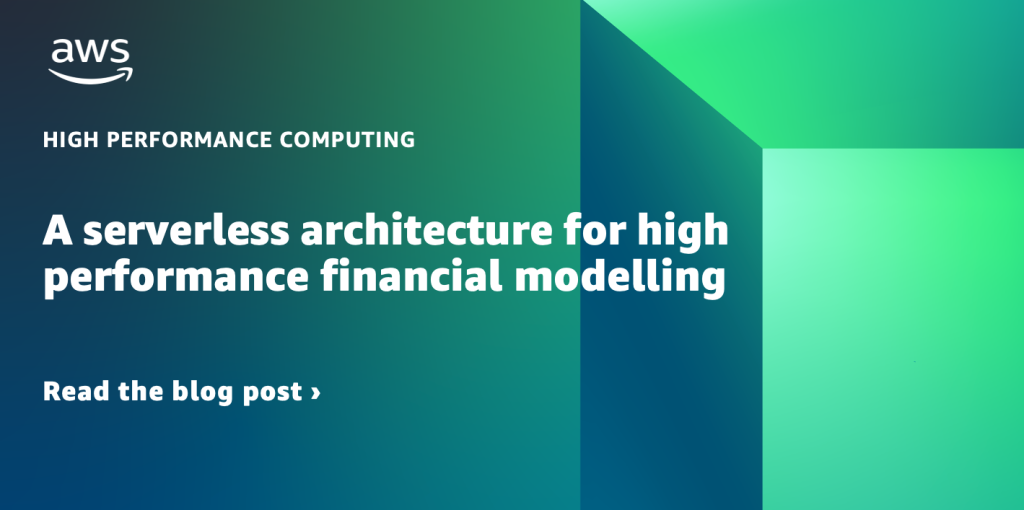AWS HPC Blog
A serverless architecture for high performance financial modelling
Understanding deal and portfolio risk and capital requirements is a computationally expensive process that requires the execution of multiple financial forecasting models every day and in often in real time. This post describes how it works at RenaissanceRe, one of the world’s leading reinsurance companies.
Simulating 44-Qubit quantum circuits using AWS ParallelCluster
A key part of the development of quantum hardware and quantum algorithms is simulation using existing classical architectures and HPC techniques. In this blog post, we describe how to perform large-scale quantum circuits simulations using AWS ParallelCluster with QuEST, the Quantum Exact Simulation Toolkit. We demonstrate a simple and rapid deployment of computational resources up to 4,096 compute instances to simulate random quantum circuits with up to 44 qubits. We were able to allocate as many as 4096 EC2 instances of c5.18xlarge to simulate a non-trivial 44 qubit quantum circuit in fewer than 3.5 hours.
Accelerating Genomics Pipelines Using Intel’s Open Omics Acceleration Framework on AWS
In this blog, we showcase the first version of Open Omics and benchmark three applications that are used in processing NGS data – sequence alignment tools BWA-MEM, minimap2, and single cell ATAC-Seq on Xeon-based Amazon Elastic Compute Cloud (Amazon EC2) Instances.
Building a Scalable Predictive Modeling Framework in AWS – Part 3
In this final part of this three-part blog series on building predictive models at scale in AWS, we will use the synthetic dataset and the models generated in the previous post to showcase the model updating and sensitivity analysis capabilities of the aws-do-pm framework.
Building a Scalable Predictive Modeling Framework in AWS – Part 2
In the first part of this three-part blog series, we introduced the aws-do-pm framework for building predictive models at scale in AWS. In this blog, we showcase a sample application for predicting the life of batteries in a fleet of electric vehicles, using the aws-do-pm framework.
Building a Scalable Predictive Modeling Framework in AWS – Part 1
Predictive models have powered the design and analysis of real-world systems such as jet engines, automobiles, and powerplants for decades. These models are used to provide insights on system performance and to run simulations, at a fraction of the cost compared to experiments with physical hardware. In this first post of three, we described the motivation and general architecture of the open-source aws-do-pm framework project for building predictive models at scale in AWS.
Running large-scale CFD fire simulations on AWS for Amazon.com
In this blog post, we discuss the AWS solution that Amazon’s construction division used to conduct large-scale CFD fire simulations as part of their Fire Strategy solutions to demonstrate safety and fire mitigation strategies. We outline the five key steps taken that resulted in simulation times that were 15-20x faster than previous on-premises architectures, reducing the time to complete from up to twenty-one days to less than one day.
Expanded filesystems support in AWS ParallelCluster 3.2
AWS ParallelCluster version 3.2 introduces support for two new Amazon FSx filesystem types (NetApp ONTAP and OpenZFS). It also lifts the limit on the number of filesystem mounts you can have on your cluster. We’ll show you how, and help you with the details for getting this going right away.
Slurm-based memory-aware scheduling in AWS ParallelCluster 3.2
AWS ParallelCluster version 3.2 now supports memory-aware scheduling in Slurm to give you control over the placement of jobs with specific memory requirements. In this blog post, we’ll show you how it works, and explain why this will be really useful to people with memory-hungry workloads.
Call for participation: RADIUSS Tutorial Series
Lawrence Livermore National Laboratory (LLNL) and AWS are joining forces to provide a training opportunity for emerging HPC tools and application. RADIUSS (Rapid Application Development via an Institutional Universal Software Stack) is a broad suite of open-source software projects originating from LLNL. Together we are hosting a tutorial series to give attendees hands-on experience with these cutting-edge technologies. Find out how to participate in these events in this blog post.









